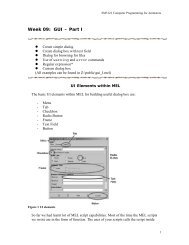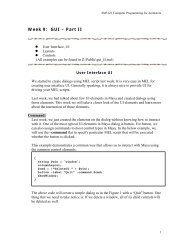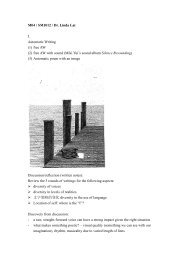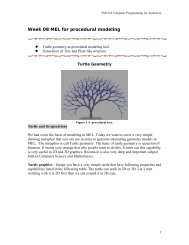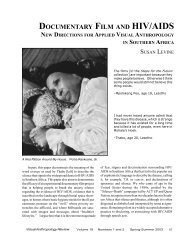Performativity: intervening the everyday, eventmaking in city space
Performativity: intervening the everyday, eventmaking in city space
Performativity: intervening the everyday, eventmaking in city space
You also want an ePaper? Increase the reach of your titles
YUMPU automatically turns print PDFs into web optimized ePapers that Google loves.
<strong>Performativity</strong>:<br />
<strong><strong>in</strong>terven<strong>in</strong>g</strong> <strong>the</strong> <strong>everyday</strong>, eventmak<strong>in</strong>g <strong>in</strong> <strong>city</strong> <strong>space</strong><br />
Media Art: Theory & Practice I<br />
Version Sem B, 2008<br />
L<strong>in</strong>da C.H. LAI
Performative<br />
• Speech act: a promise, bet, or contract<br />
• 2 types:<br />
> clearly marked<br />
> diffused
The “performative” as a concept:<br />
performance suffus<strong>in</strong>g an act or an activity<br />
constructed social reality
A l<strong>in</strong>guistic def<strong>in</strong>ition of <strong>the</strong> performative<br />
(a term co<strong>in</strong>ed by J.L. Aust<strong>in</strong>…)<br />
– a semiotic gesture (play with language)<br />
– be<strong>in</strong>g as well as do<strong>in</strong>g:<br />
> a do<strong>in</strong>g that constitutes a be<strong>in</strong>g…(<strong>the</strong> process of play<strong>in</strong>g out<br />
one’s subjectivity <strong>in</strong> a specific moment and place)<br />
> an activity that creates what it describes
Performative<br />
Performatives are <strong>in</strong>telligible only with<strong>in</strong> a matrix that is<br />
simultaneously social and semiotic.<br />
> depends on a densely woven web of social relations that renders<br />
it <strong>in</strong>telligible, believable, and acceptable<br />
> <strong>in</strong>volves selflegitimat<strong>in</strong>g power<br />
> Shift of context of <strong>the</strong> utterance shift or loss of cultural<br />
authority.<br />
However, a “shift” can also be a parody of dom<strong>in</strong>ant conventions: to<br />
show that <strong>the</strong>re are conventions… (Judith Butler) e.g. to pronounce<br />
a pair of women husband and wife…
Performative<br />
<strong>Performativity</strong> <strong>the</strong>refore <strong>in</strong>volves daily behavior based on <strong>everyday</strong><br />
norms or habits.<br />
<strong>Performativity</strong> works through <strong>the</strong> norm of reiteration.<br />
For example,<br />
“Gender” is NOT someth<strong>in</strong>g one is, but someth<strong>in</strong>g one does…<br />
• There is no essential identity: gender is performance. It’s what you<br />
do at particular times, ra<strong>the</strong>r than a universal you.<br />
• We perform different identities/selves <strong>in</strong> <strong>the</strong> world.
<strong>Performativity</strong><br />
• Judith Butler describes performativity as “…that<br />
reiterative power of discourse to produce <strong>the</strong><br />
phenomena that it regulates and constra<strong>in</strong>s.” (Butler quoted<br />
<strong>in</strong> Identity: A reader, 2000)<br />
• Key: repetition
Performance VS <strong>Performativity</strong><br />
• Performance presupposes a preexist<strong>in</strong>g subject;<br />
performativity contests <strong>the</strong> very notion of <strong>the</strong> subject<br />
• Performance: subject precedes <strong>the</strong> act<br />
• <strong>Performativity</strong>: <strong>the</strong> act constructs <strong>the</strong> (identity of) subject<br />
• collapse of differences between “fiction” and <strong>the</strong><br />
“real”
Case studies: Vito Hannibal Acconci<br />
Individual moments of urban reality:<br />
collapse of differences between “fiction” and <strong>the</strong> “real”<br />
create fiction or story <strong>in</strong> <strong>everyday</strong> liv<strong>in</strong>g <strong>space</strong><br />
<strong>in</strong>teraction with <strong>the</strong> public and play with <strong>the</strong> <strong>space</strong>
Vito Hannibal Acconci (b. 1940)<br />
In <strong>the</strong> 1960s, his preoccupations were now orientated towards "real<br />
<strong>space</strong>” (for example, <strong>the</strong> physical <strong>space</strong>, <strong>the</strong> social <strong>space</strong>, <strong>the</strong><br />
cultural <strong>space</strong>, <strong>the</strong> daytoday, time) which he explored us<strong>in</strong>g<br />
various media.<br />
In <strong>the</strong> early 1970s, he was known for his performance and video<br />
works.<br />
Beg<strong>in</strong>n<strong>in</strong>g <strong>in</strong> <strong>the</strong> 1980s, he concerned himself with private domestic<br />
<strong>space</strong>s and public <strong>space</strong>s for <strong>in</strong>teraction. His many projects <strong>in</strong>clude<br />
parks, playgrounds, and "antimonuments".
Vito Acconci: Follow<strong>in</strong>g Pieces (1969)
Acconci’s Spy Project<br />
• From midnight, April 16, to midnight, May 12, at all times, a<br />
“spy” was assigned to <strong>the</strong> outside of Peters Hall (which houses<br />
<strong>the</strong> offices of <strong>the</strong> dean of students, <strong>the</strong> dean of men, <strong>the</strong><br />
registrar, etc.). The spy’s task was to watch <strong>the</strong> entrance or<br />
entrances fac<strong>in</strong>g <strong>the</strong> Memorial Arch.<br />
• Every hour, on <strong>the</strong> hour, <strong>the</strong> spy took a color photograph of<br />
what he is watch<strong>in</strong>g.<br />
• The photographs were sent to <strong>the</strong> artist; <strong>the</strong> results of <strong>the</strong> piece<br />
formed his collection of <strong>in</strong>formation.
(Untitled) Project for Pier 17 (1971)<br />
• “From March 27 to April 24, 1971, I will be at Pier 17 (an abandoned pier at<br />
West Street and Park Place, New York). At I am each night; I will be alone,<br />
and will wait at <strong>the</strong> far end of <strong>the</strong> pier for one hour.”<br />
• “To anyone com<strong>in</strong>g to meet me, I will attempt to reveal someth<strong>in</strong>g I would<br />
normally keep concealed: censurable occurrences and habits, fears,<br />
jealousies – someth<strong>in</strong>g that has not been exposed before and that would be<br />
disturb<strong>in</strong>g for me to make public.”<br />
• Ask<strong>in</strong>g <strong>the</strong> viewer to keep this secret, Acconci <strong>the</strong>n <strong>in</strong>vited <strong>the</strong>m to demand<br />
someth<strong>in</strong>g from him, even blackmail him.<br />
Acconci was often <strong>the</strong> protagonist <strong>in</strong> his early works and regularly<br />
<strong>in</strong>vited viewer participation. (Untitled) Project for Pier 17, for<br />
example, was conducted as tools for selfanalysis as well as<br />
explorations <strong>in</strong>to human relationships.
(Untitled) Project for Pier 17 (1971)
• Nov 23,1969; afternoon.<br />
Vito Acconci: Bl<strong>in</strong>ks<br />
• PhotoPiece, Greenwich Street, NYC; Kodak Instamatic 124, b/w<br />
film<br />
Hold<strong>in</strong>g a camera, aimed away from me and ready to<br />
shoot, while walk<strong>in</strong>g a cont<strong>in</strong>uous l<strong>in</strong>e down a <strong>city</strong><br />
street.<br />
Try not to bl<strong>in</strong>k.<br />
Each time I bl<strong>in</strong>k: snap a photo.
Vito Acconci: Bl<strong>in</strong>ks
Acconci: Virtual Intelligence Mask (1993)
Virtual Intelligence Mask (1993)<br />
A conventional fenc<strong>in</strong>g mask is used as a supportstructurefor<br />
electronics; <strong>the</strong> electronics are used as contact with <strong>the</strong> world<br />
outside.<br />
On <strong>the</strong> front of <strong>the</strong> mask are three televisions: one larger television<br />
fac<strong>in</strong>g out, and two m<strong>in</strong>iature televisions fac<strong>in</strong>g <strong>in</strong>….<br />
http://www.medienkunstnetz.de/works/virtual<strong>in</strong>telligencemask/
• French, born 1953<br />
Case studies: Sophie Calle<br />
• French conceptual artist <strong>in</strong>fluenced by Oulipo<br />
• personal <strong>in</strong>vestigation <strong>the</strong> terms and parameters of<br />
subject/object, <strong>the</strong> public versus <strong>the</strong> private, and role play<strong>in</strong>g.<br />
• Interest <strong>in</strong> <strong>the</strong> fluid levels of reality reality (<strong>the</strong> archive)<br />
transformed <strong>in</strong>to fiction (narration), and vice versa. conceal<br />
<strong>the</strong> borders between art and life, fiction and reality, and private<br />
and public.<br />
• Artmak<strong>in</strong>g: accumulation of experiences and memories
Case studies: Sophie Calle<br />
Double Game<br />
a book project that is a documentation of Calle’s performative<br />
projects and well as <strong>the</strong> performative itself<br />
Paul Auster’s novel: Leviathan<br />
– Uses Calle as a bluepr<strong>in</strong>t for <strong>the</strong> character design<br />
– pg.6067 Uses a number of episodes from Calle’s life to create<br />
a fictive character named Maria<br />
– M<strong>in</strong>gl<strong>in</strong>g fact with fiction.<br />
Sophie Calle’s game: Double Game<br />
• Autobiography<br />
• Turn<strong>in</strong>g <strong>the</strong> novel <strong>in</strong>to a game and make her own particular mixture<br />
of reality and fiction – she lived <strong>the</strong> life of Maria
<strong>Performativity</strong> and Sophie Calle: “Double Game”: To be Like Maria<br />
• The life of Maria and how it<br />
<strong>in</strong>fluenced life of Sophie<br />
– Chromatic regimen<br />
– Alphabetic <strong>the</strong>me of a day<br />
• Calle followed <strong>the</strong> author’s<br />
<strong>in</strong>structions<br />
The birthday ceremony<br />
• The life of Sophie and<br />
how it <strong>in</strong>fluenced life of<br />
Maria<br />
– The wardrobe<br />
– The striptease<br />
– To follow…<br />
– Suite venitienne<br />
– The detective<br />
– The hotel<br />
– The address book<br />
– The birthday ceremony
<strong>Performativity</strong> and Sophie Calle: “Double Game”: Chromatic Diet<br />
• To be Like Maria…<br />
• The Chromatic Diet<br />
– In <strong>the</strong> novel, Maria restricted herself to foods of a s<strong>in</strong>gle color on<br />
any given day<br />
– Calle followed <strong>the</strong> book and added <strong>in</strong> her own th<strong>in</strong>gs:<br />
• e.g. add<strong>in</strong>g orange juice <strong>in</strong>to <strong>the</strong> menu, sett<strong>in</strong>g out <strong>the</strong> full<br />
chromatic menu for six guests on Sunday
The Chromatic Diet
The Chromatic Diet
The Chromatic Diet
The Chromatic Diet
Researchbased projects: <strong><strong>in</strong>terven<strong>in</strong>g</strong> <strong>everyday</strong> life: The Hotel / To Follow<br />
The Hotel<br />
– Worked <strong>in</strong> a hotel as a temporary chambermaid for 3 weeks<br />
(February – March, 1981)<br />
– She was assigned 12 rooms <strong>in</strong> her care<br />
– Exam<strong>in</strong>ed <strong>the</strong> personal belong<strong>in</strong>gs of <strong>the</strong> hotel guests and<br />
observed through details lives which rema<strong>in</strong>ed unknown to her<br />
To Follow…<br />
– Followed strangers on <strong>the</strong> street, took photos and took note of<br />
<strong>the</strong>ir movements
1983<br />
Interven<strong>in</strong>g <strong>the</strong> <strong>everyday</strong>: The Address Book (1983)<br />
• Found a address book<br />
• Asked <strong>the</strong> people <strong>in</strong> <strong>the</strong> book to tell her about <strong>the</strong> owner<br />
• Discovered a man whom she produced a portrait of without<br />
meet<strong>in</strong>g him
The Birthday Ceremony (19811993)<br />
• Worried people will forget her<br />
• 1980, release herself of this anxiety, decided every year, on<br />
October 9, <strong>in</strong>vite to d<strong>in</strong>ner <strong>the</strong> exact number of people<br />
correspond<strong>in</strong>g to her age, <strong>in</strong>clud<strong>in</strong>g a stranger chosen by one<br />
of my guests<br />
• Don’t use <strong>the</strong> presents<br />
• put an end at Age 40
<strong>Performativity</strong>, Sophie Calle, and more…<br />
• The act of imposture has been widely used by artists: Sophie Calle, C<strong>in</strong>dy<br />
Sherman<br />
The function of<br />
imposture for most<br />
artists is to effectuate a<br />
critique of <strong>the</strong> identitarian<br />
categories that <strong>in</strong>form<br />
debates about gender,<br />
race and sexuality.<br />
Unititled Film Still #14, 1978 C<strong>in</strong>dy Sherman
• Double Bl<strong>in</strong>d (1992) with<br />
Gregory Shephard<br />
• quasidocumentary<br />
• produced and documented a reallife<br />
narrative of <strong>the</strong>ir journey —<br />
and <strong>the</strong>ir relationship<br />
More on Sophie Calle
MORE CASES OF PERFORMATIVITY (DISCUSSED IN CLASS)<br />
Door Game (L<strong>in</strong>da Lai / 2005)<br />
Jeanne Dielman, 23, quai du commerce, 1080 Bruxelles (Chantal<br />
Akerman, 1975)<br />
The Gleaners and I ( Agnes Varda, 2000) +<br />
The Gleaners and I Two Years Later (Agnes Varda, 2002)
MORE CASES OF PERFORMATIVITY (DISCUSSED IN CLASS)<br />
Door Game (L<strong>in</strong>da Lai / 2005)<br />
Simultaneously social and semiotic:<br />
Conventions of melodrama / gender role stereotypes (semiotic)<br />
Ideal personhood / paradigms of social relation (social)<br />
Open<strong>in</strong>g up: challeng<strong>in</strong>g stable narratives, narrative coherence, and narrative<br />
closure<br />
The work evolves from some sort of a comprehensive story (formulaic mannerism) to a<br />
series of image and text (openness of a photographic image) to <strong>the</strong> sheer act of<br />
tear<strong>in</strong>g apart whereby speech and words took over images and f<strong>in</strong>ally end as pure<br />
“noise”… The work can actually cont<strong>in</strong>ue on and on with more and more sections.<br />
Reiteration + repetition:<br />
The serial structure is endless, each of <strong>the</strong> 3 parts demonstrate how <strong>the</strong> same pool of raw<br />
material can result <strong>in</strong> very different works of very different looks and very different<br />
speech acts.<br />
Speech Act:<br />
The work and its entirety is <strong>the</strong> process of contemplat<strong>in</strong>g narrative mannerism than <strong>the</strong><br />
arrival <strong>in</strong> settled conclusion.
MORE CASES OF PERFORMATIVITY (DISCUSSED IN CLASS)<br />
Jeanne Dielman, 23, quai du commerce, 1080 Bruxelles (Chantal Akerman,<br />
1975)<br />
The work’s basic c<strong>in</strong>ematic grammar – susta<strong>in</strong>ed long still shot, no camera movement,<br />
tableau setup with a heightened sense of composition and organization of screen<br />
<strong>space</strong> – places <strong>the</strong> viewer <strong>in</strong> <strong>the</strong> mode of attentive contemplation, heightened sense<br />
of see<strong>in</strong>g…<br />
View<strong>in</strong>g habit is challenged: what do we see? What should we see? What else is <strong>the</strong>re<br />
(o<strong>the</strong>r than for plot comprehension, eventfulness…)?<br />
The impact of <strong>in</strong>tense see<strong>in</strong>g opens up <strong>the</strong> possible mean<strong>in</strong>gs of an observable surface.<br />
A woman is more than a woman: she may be, she may be…she is, she is…<br />
Act<strong>in</strong>g for a preassigned dramatic role now becomes a performance that destabilize a<br />
fixed role. The view<strong>in</strong>g process keeps (re)construct<strong>in</strong>g who <strong>the</strong> person is via ongo<strong>in</strong>g<br />
performance.<br />
Simultaneously social and semiotic… Repetition and details work toge<strong>the</strong>r to open up…
MORE CASES OF PERFORMATIVITY (DISCUSSED IN CLASS)<br />
The Gleaners and I ( Agnes Varda, 2000) +<br />
The Gleaners and I Two Years Later (Agnes Varda, 2002)<br />
The film itself can be understood as simply a documentary.<br />
The film <strong>in</strong> fact is an audiovisual record of a performative project / journey of<br />
Varda’s…<br />
It is a journey of discovery, open<strong>in</strong>g up <strong>the</strong> multiple implications and connective<br />
power of a gleaner and glean<strong>in</strong>g, by keep<strong>in</strong>g open <strong>the</strong> questions: who is a<br />
gleaner? What does it mean to glean….? In <strong>the</strong> end, <strong>the</strong> work touch upon<br />
issues of poverty, homelessness, social marg<strong>in</strong>ality, conservation of <strong>the</strong><br />
earth resources, artistic creation, and activist impulses to break <strong>in</strong>to <strong>the</strong> core<br />
of modern/urban life.<br />
The film <strong>the</strong>refore demonstrates <strong>the</strong> productivity and richness of <strong>the</strong> act of<br />
“open<strong>in</strong>g up” and refusal to settle on a particular type of conclusive f<strong>in</strong>d<strong>in</strong>gs.<br />
The performative force of <strong>the</strong> project lies also <strong>in</strong> <strong>the</strong> revisit 2 years after film<strong>in</strong>g.<br />
It seems like this work is always <strong>in</strong> progress, and can carry on its life<br />
cont<strong>in</strong>uously (at least <strong>the</strong>oretically speak<strong>in</strong>g…)



